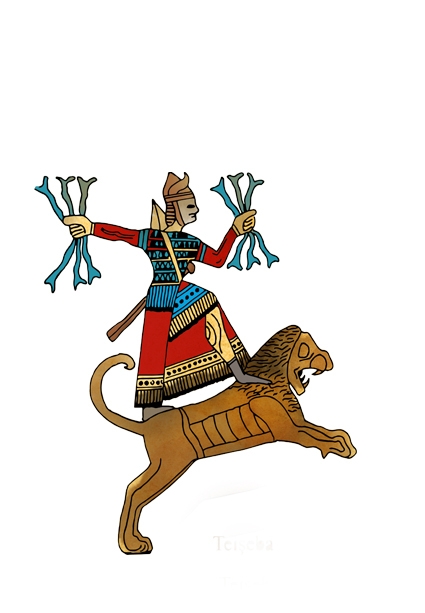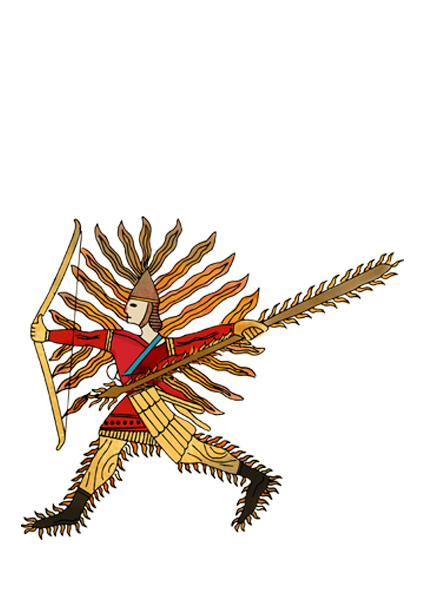Urartian religion is polytheistic. Our knowledge of the nature and practices of religion comes from a few inscriptions and more archaeological findings. The head god Haldi is the national god of Urartu. In the stelas, rock monuments and building inscriptions, the kings begin with his name:
“Ispaini's son Minua opened this channel through the power of God Haldi. Its name is Minua channel”.
In Urartian inscriptions, the name of god Haldi begins to be called with the King Ispirini for the first time. It is also suggested that the standard structures and practices of Urartian religion emerged during this period. However, it should be taken into consideration that the Urartian inscriptions are rather limited before the Ispini Period.
One of the most important inscriptions we have learned about Urartian religious and religious practices is the Meher Gate inscription in Van city center. This is the most important reference source for Urartian religion. This monument, which is a part of outdoor sanctuary, was built on the road route opened to east from Tuşpa and near Toprakkale. The cuneiform writing in the door-shaped niche, gradually carved into the main rock, determines the name of the 79 Urartian gods and the number and nature of the victims to be presented to them. In the written text with cuneiform, the gods are ranked according to their importance. The victims presented to the gods prove the quality of this ranking. It is understood that animals in the strain of bull and sheep were sacrified for gods and the cow and again the sheep were sacrificed to goddesses. It is seen that the sacrifices are also offered to the qualities of some Gods. For example, to the mercy and power of God Haldi... Again it is seen to be made a vow for mountains, lakes and cities.
|
İşpuini, the son of Sarduri and Minua, the Son of İşpuini built this door to Head God Haldi and issued a decree: …
To the Gods:
17 bulls and 34 sheeps to God Haldi;
6 bulls and 12 sheeps to God Teiseba;
4 bulls and 8 sheeps to God Şivini;
2 bulls and 4 sheeps to God Hutuini;
1 bull and 2 sheeps to God Turani;
2 bulls and 4 sheeps to God Ua;
2 bulls and 4 sheeps to God Nalaini;
2 bulls and sheep to God Sebitu;
2 bulls and 4 sheeps to God Arsimela;
1 bull and 2 sheeps to God Anapsa
|
To the qualities of God Haldi
1 bull and 2 sheeps to the spear of God Haldi;
2 bull and 4 sheeps to the army of God Haldi;
2 bull and 4 sheeps to the army of God Teiseba;
1 bull and 2 sheeps to the grandness of God Haldi;
1 bull and 2 sheeps to the mercy of God Haldi;
1 bull and 2 sheeps to the power of God Haldi;
|
|
To the Cities
1 bull and 2 sheeps to the God of Ardini City;
1 bull and 2 sheeps to the God of Qumenu City;
1 bull and 2 sheeps to the God of Tuşpa City;
1 bull and 2 sheeps to the God of Haldi City;
|
|
To the Nature;
1 bull and 2 sheeps to the God of mountains;
1 bull and 2 sheeps to the God of lakes;
|
To the Goddesses
1 cow and 1 sheep to the Goddess Arubaini;
1 cow and 1 sheep to the Goddess Huba;
1 cow and 1 sheep to the Goddess Tuşpu;
1 cow to the Goddess Aui;
|
|
Ispuini, the son of Sarduri, and Minua, the son of Ispuini, have set up new vineyards. They also set up new gardens for God Haldi. (before that) nothing was done there. Ispuini, the son of Sarduri, and Minua, the son of Ispuini have been farmed new fields and issued a decree: When the vineyards are ……, 3 sheeps to God Haldi and 3 sheeps to all gods are sacrificed. When the vineyards are ……, 3 sheeps to God Haldi and 3 sheeps to all gods are sacrificed. Vine …. (2x)
|
Our knowledge of Urartian religion is based on the interpretation of archaeological findings and material cultural remains, except for the inscriptions. The depictions on metal and some stone artifacts, architectural practices and burial customs are the leading.
The head god of the Urartian pantheon is Haldi as we mentioned above. Although God Haldi did not draw attention as an important god in the Near East before Urartu, it is known that Haldi name was used in some people in Southeast Anatolia. The god motif in Urartu of this name which is understood to be Hurrian, is specific to this culture. In addition, according to the Meher Gate inscription, we know that Teişeba and Şivini, who are in second and third order, are the gods of Hurrians, who were accepted in a wide geography.
The depictions on the bronze shield located just outside the Van Anzaf Haldi Temple give unique information about the depictions and functions of the Urartian god. When the Meher Gate is taken as reference, it is understood that the god at the top of the stage is Haldi. In the depiction on the shield, there was a war in front of Haldi, and probably the lions on which the Haldi stood were actively engaged in the war. The whole body and the pike of Haldi beams flame. In some inscriptions, it is understood that some of the items and weapons of Haldi were also blessed and the sacrifice was offered to them. In this depiction, the flaming pike in the hands of Haldi is indicated on the battlefield in front of him as sticked to the enemy soldiers. This shows that a narrative wording on the shield describes a process. Teişeba, described as standing on the lion and Şivini, staying on the bulla re located behind Haldi. Teisheba has lightning bundles in its hand. Shivini is described the sun course. Behind these, the other gods are arranged in a standing position on mixed creatures.
Considering the Anzaf Shield and other descriptions of God, in Urartu we are able to determine the characteristics/ atributes of the three gods in general. God Haldi flames in Anzaf Shield differently. God Teişeba holds lightning bundles in both hands and is described on the lion. In some examples we see Teişeba on the bull. The most prominent feature is that he has hold lightning bundles in his hands. Şivini was described sometimes on the lion sometimes on the bull as in the Anzaf Shield. The most distinctive feature of the Near East is that it is depicted by the solar course. The other gods follow these three great gods. These gods were named with reference to Meher Gate inscription. There are one for each weapons in both hands of the Gods that drawn in standing position on four-legged mixed animals. It is understood that they were involved in the war in favor of Urartians in the pursuit of the three god in front.
TANRI TEİŞEBA

TANRI HALDİ





